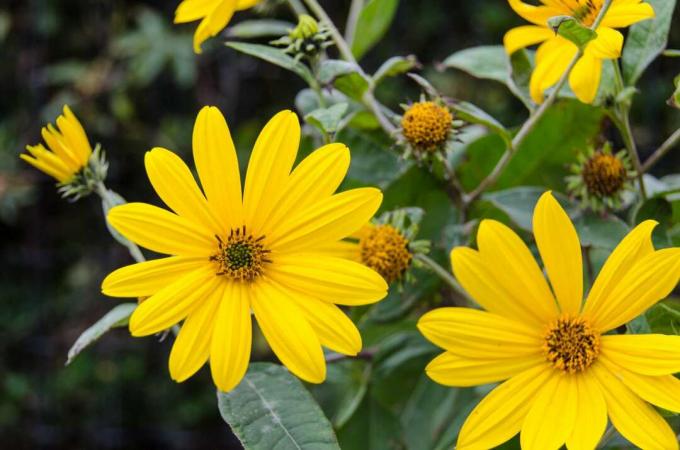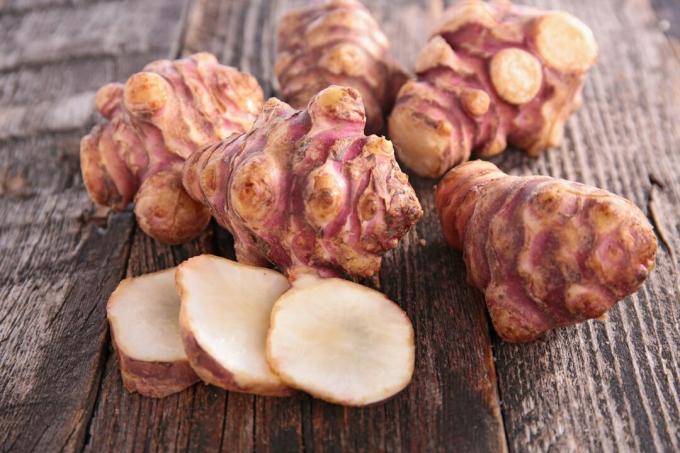Jerusalem artichoke was already in the 17th An important food in Europe in the 19th century and has been on the rise again for some time. What many do not know: The tasty and low-calorie tuber can be grown in the garden without any problems.

Jerusalem artichoke is a perennial, historical vegetable that was rediscovered a few years ago and has been grown increasingly since then. But what is Jerusalem artichoke? And where is he from? We introduce the tuber-forming sunflower and give tips for growing it in your own garden.
contents
- Jerusalem artichoke: origin and characteristics
- Risk of confusion: Jerusalem artichoke-like plants
- Caring for Jerusalem artichokes: cutting, fertilizing & Co.
- Common pests and diseases of Jerusalem artichoke
- Wintering Jerusalem artichokes
- Propagation of Jerusalem artichoke
-
Harvest and store Jerusalem artichokes
- Harvest Jerusalem artichoke
- Storage of Jerusalem artichoke
- Is Jerusalem artichoke healthy?
- Ingredients and uses of Jerusalem artichoke in the kitchen
Jerusalem artichoke: origin and characteristics
Jerusalem artichoke (Helianthus tuberosus), also called earth pear or earth artichoke, came to Europe from North America around 1600 and supplied the population of that time with carbohydrates. In the 18th In the 19th century, the potato replaced the Jerusalem artichoke tubers as food, and they were still grown as fodder for cattle and wild animals. Until a few years ago, vegetables were largely forgotten. Only the return to tried and tested regionally grown vegetables brought the tasty tuber back into the gardens and onto our plates. But what does Jerusalem artichoke actually look like?
Jerusalem artichoke forms long shoots above ground with many side branches covered with rough, sunflower-like leaves. The branches are bulky and break off easily in the wind. The Jerusalem artichoke can bloom from August, but it does not always and only with certain varieties. The plant reaches a height of 2.5 to 3 meters. If one looks at the flowers of Jerusalem artichoke, it is hardly surprising that the plant is very closely related to the sunflower (Helianthus annuus) Is related. Both plants have a sun-yellow halo around the button-shaped, brownish-yellow tubular flowers in the middle. The plant will only bloom when the days get shorter. In Germany this is already from August, in some of the Mediterranean countries not until October.
What is exciting, however, is what is formed underground at the roots of the Jerusalem artichoke. In the course of the summer, oval to conical rhizome bulbs form, which can be white inside and brownish to deep red on the outside. At the tips of the irregularly shaped rhizome tubers, there are buds for the next year's shoots. Jerusalem artichoke reproduces itself vegetatively through the rhizomes. The taste of these tubers is aromatic, earthy and a little nutty, but is also often described as artichoke-like. This has earned the tuber the nickname earth artichoke. There is a wide range of options Jerusalem artichoke varieties, which differ in flowering ability, height, stability, yield and color of the rhizome tubers.

Nowadays, Jerusalem artichoke is also used for fructose production, as an energy plant for the production of biofuels and as a fodder plant. Only from the sugar beet can more biomass per hectare be obtained for the production of bioethanol. As a renewable raw material, Jerusalem artichoke can also be processed into wood chips and burned in a pellet heating system. The energy content of the yield of one hectare of Jerusalem artichoke corresponds to over 6000 liters of heating oil. Jerusalem artichoke is therefore a high-performance plant in all areas, from nutrition to energy generation.
Note on toxicity: Jerusalem artichoke is not poisonous, the leaves are eaten by animals such as rabbits. The rhizome tubers can also be eaten raw.
Risk of confusion: Jerusalem artichoke-like plants
Outwardly, Jerusalem artichoke can be confused with some of its relatives. However, if you take a look into the ground, only Jerusalem artichoke has the desired, tasty tubers. A mix-up is actually impossible. Plants similar to Jerusalem artichoke are the sun's eye (Heliopsis sp.) or the streaky Silphie (Silphium perfoliatum), which is now grown on many fields for biogas production.
Caring for Jerusalem artichokes: cutting, fertilizing & Co.
Jerusalem artichoke grows on almost all types of soil, but prefers sandy and humus clay soils. The water requirement of the Jerusalem artichoke is very high, simply because of the large biomass that is formed. The soils should be able to store moisture well and release it if necessary, but waterlogging should be avoided at all costs. Jerusalem artichoke tolerates full sun and hot days very well, provided there is enough water.
After the tubers have been planted in the ground between late March and mid-May, the first shoots begin to shoot quickly. In dry years it should be watered regularly at the beginning, so the Jerusalem artichoke quickly builds up the necessary root mass. The yield can be increased through regular fertilization, especially on poor soils. Our Plantura organic tomato fertilizer With its increased potassium content, it has an optimal composition for the tuber growth of the Jerusalem artichoke. Excessive amounts of nitrogen, for example through fresh manure, instead promote shoot growth, the tubers remain smaller and the storage life decreases. During planting and two months afterwards, the granulated fertilizer is added to the Jerusalem artichoke plants and worked in on the surface.
If the Jerusalem artichoke is to be used as food, the shoots can be cut off and fed once in summer and once in autumn. If you want to harvest the tubers, you just let the plant grow in peace. In windy locations, the tall but not particularly stable perennial should be tied to a sturdy stake.
Common pests and diseases of Jerusalem artichoke
You can do without pest and disease control when growing in your own garden. Jerusalem artichoke is very robust and resistant. In wet, cool years, the Powdery mildew appear. The only known pest is the vole, which finds a delicacy at eye level in the tubers and can ingest the entire harvest. If Jerusalem artichoke is grown on the same area for years, the base of the shoots can rot Sclerotinia come. Since this fungus persists in the soil, infected plants should be disposed of and the area should be changed urgently in the next year.
Wintering Jerusalem artichokes
Jerusalem artichokes can stay in the ground for several years, with good care even for up to 20 years and sprout fresh every spring and form new tubers. To do this, you only dig up part of the rhizome tubers in autumn and leave the rest in the ground. The Jerusalem artichoke tubers rest during the winter, overwinter and reliably sprout again in the next spring.
Propagation of Jerusalem artichoke
Jerusalem artichoke, like the potato, can be propagated from the tubers. This type of propagation is not only very easy, a variety bought once can be propagated and maintained by yourself. The tubers harvested in autumn are stored for the winter and moved to a new location next spring. Only in the breeding of new varieties are seeds produced and sown. Naturally, in our latitudes, the seeds usually do not mature in the first place - it is not warm long enough here. The propagation of Jerusalem artichoke via the tubers is therefore usually the only practicable way.

Note on removing Jerusalem artichoke: Jerusalem artichoke can become a real nuisance as it often grows sprawling and forms strong shoots from all the tubers that remain in the ground. Here you have to dig deeply and remove all rhizome tubers if possible to prevent it from spreading. Completely removing Jerusalem artichoke from the garden is only possible with a lot of effort and regular digging and digging of the tubers.
Harvest and store Jerusalem artichokes
The huge plants suggest a rich yield in summer, but when do you harvest and how do you store Jerusalem artichokes correctly? There are a few points to consider here. We have summarized the essential steps for you.
Harvest Jerusalem artichoke
As soon as the leaves of the Jerusalem artichoke plant fall off and the stems become dry, the harvest time begins. This is mostly the case with us from the end of October to November. Now is the season for the Jerusalem artichoke tubers, which are only available for a short time on the vegetable market. As with the potato harvest, you cut off the soil around the plant generously with a spade and dig it out together with the tubers. In addition to the classic tools, there are also so-called potato shovels or digging forks, with which the soil can be shaken off the tubers particularly easily. If the individual tubers are already detached from the roots, they are really ready to be harvested and can be stored for the longest. In principle, you can harvest the whole winter until March before the tubers sprout again.

Storage of Jerusalem artichoke
The skin of Jerusalem artichoke is quite thin, which is why the tubers can only be stored in the refrigerator for one to two weeks. The best storage takes place in damp sand in a cool cellar. In this way, the tubers will also be overwintered for the next year if they do not stay in the ground anyway. In contrast to potatoes, Jerusalem artichokes are very hardy and can be harvested as winter vegetables until they sprout in March. Only the ground should not be frozen, because this makes harvesting very difficult and the tubers are quickly damaged. Alternatively, you can freeze the harvested Jerusalem artichoke tubers, which will keep them for about a year.
Is Jerusalem artichoke healthy?
Jerusalem artichoke is an extremely healthy vegetable, which, in addition to filling carbohydrates, also contains a lot of vitamins and minerals. Diabetics in particular benefit from the inulin it contains, a type of carbohydrate that prevents blood sugar levels from rising.
Ingredients and uses of Jerusalem artichoke in the kitchen
The Jerusalem artichoke tubers consist of approx. 3% from proteins and about 16% from carbohydrates, half of which is inulin. Our stomach treats the inulin like fiber, which has a positive effect on digestion, but does not raise blood sugar levels. With a calorific value of 30 kcal per 100 g, Jerusalem artichoke has fewer than half the calories compared to potatoes. In addition to vitamins A, B1 and B2, the healthy Jerusalem artichoke tuber offers many nutrients, such as potassium and iron, in high concentrations.
Jerusalem artichoke can be eaten raw and has a pleasant nutty taste. However, the tuber is usually cooked or cooked and is used in various dishes. A classic of the old cuisine is a Jerusalem artichoke soup. As oven vegetables, the tuber vegetables can be prepared with a little oil, mustard, curry powder, salt and pepper. By the way, Jerusalem artichokes do not have to be peeled; the tubers are only cleaned with a little water and a mushroom brush. The Jerusalem artichoke is dried in wafer-thin slices and eaten as chips. In specialty shops there is also Jerusalem artichoke syrup with a high fructose content. Some specialists even extract schnapps or a brandy, the so-called "Jerusalem artichoke" or "Rossler", from the tubers.

The cultivation of the tuber vegetables begins in May with the Jerusalem artichoke plants. In our special article you will find helpful tips for growing in your own garden.


